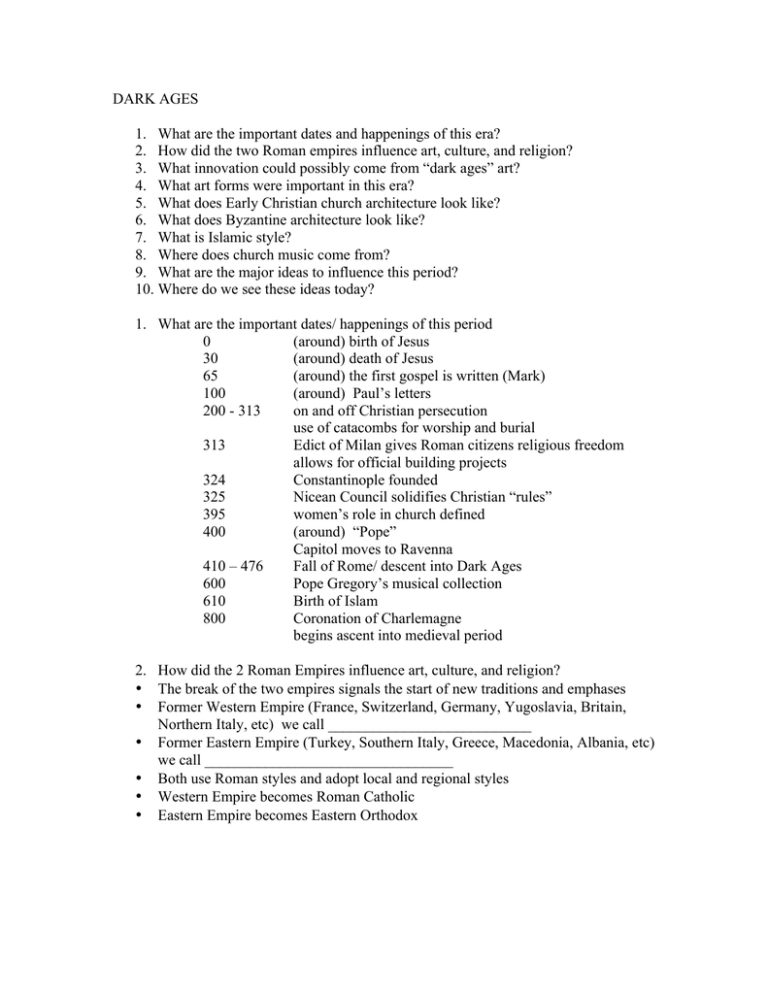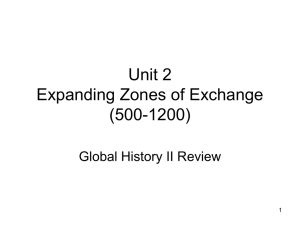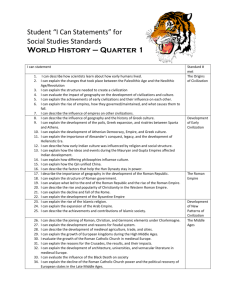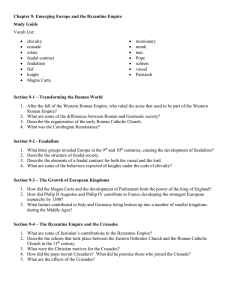DARK AGES
advertisement

DARK AGES 1. What are the important dates and happenings of this era? 2. How did the two Roman empires influence art, culture, and religion? 3. What innovation could possibly come from “dark ages” art? 4. What art forms were important in this era? 5. What does Early Christian church architecture look like? 6. What does Byzantine architecture look like? 7. What is Islamic style? 8. Where does church music come from? 9. What are the major ideas to influence this period? 10. Where do we see these ideas today? 1. What are the important dates/ happenings of this period 0 (around) birth of Jesus 30 (around) death of Jesus 65 (around) the first gospel is written (Mark) 100 (around) Paul’s letters 200 - 313 on and off Christian persecution use of catacombs for worship and burial 313 Edict of Milan gives Roman citizens religious freedom allows for official building projects 324 Constantinople founded 325 Nicean Council solidifies Christian “rules” 395 women’s role in church defined 400 (around) “Pope” Capitol moves to Ravenna 410 – 476 Fall of Rome/ descent into Dark Ages 600 Pope Gregory’s musical collection 610 Birth of Islam 800 Coronation of Charlemagne begins ascent into medieval period 2. How did the 2 Roman Empires influence art, culture, and religion? • The break of the two empires signals the start of new traditions and emphases • Former Western Empire (France, Switzerland, Germany, Yugoslavia, Britain, Northern Italy, etc) we call ___________________________ • Former Eastern Empire (Turkey, Southern Italy, Greece, Macedonia, Albania, etc) we call _________________________________ • Both use Roman styles and adopt local and regional styles • Western Empire becomes Roman Catholic • Eastern Empire becomes Eastern Orthodox 3. What innovation could possibly come from “Dark Ages” art? Problem: How do you show abstractions -- Eucharist, soul, trinity, holy spirit, etc -to a non-literate populace? Solution: a. good shepherd/ sheep b. dove c. peacock d. chrismon/ chi rho e. vine f. alpha/ omega g. mandorla h. cross i. stories/ “protagonists” through symbols 4. What art forms are important to the era? a. Sculpture -- moves to low status b. Sarcophagi c. Mosaics tesserae d. Objects of Worship Bible covers Reliquaries Chalice Paten e. Illuminated Manuscripts Book of Kells, best example Chi Rho page f. Cathedra Archbishop’s throne Archbishop’s church Ex cathedra See See 5. What does Early Christian architecture look like? Development of the church comes from the Roman basilica Men and women on separate sides of church St. Apollinaire Nuovo Note: Wooden roofs St. Peter’s in Rome Built over Peter’s tomb Largest early Christian church Latin Cross shape 6. What does Byzantine architecture look like? The central type church Dome Prothesis bread and wine Diakonikon objects Pendentive Squinch groin vault, dome topped flat roof, 8 lintels Matroneum Baptistries balcony for women modeled after Roman bath, octagonal, small A terrific example -- Hagia Sophia – 532 7. What is Islamic style? 610 – Mohammed’s vision Spread of Islam is very speedy Major Conquests of North Africa (600) and Spain (750) Islamic style is born of the Byzantine Characteristics: large domes minarets use of geometric/ repetitive art (Arabesque) decorative Arabic calligraphy symmetry bright color focus on interior Earliest example -- the Dome of the Rock, 691 Moorish Islamic -- the Great Mosque of Cordova Alhambra Mughal Islamic - Taj Mahal Mausoleum for Mumtaz Mahal Perfect symmetry, four identical facades, except for Shah Jahan’s tomb Symbolic of femininity 8. Where does church music come from? • liturgical music = music of the liturgy • first great collection of liturgical music by Pope Gregory • Gregory the Great, 590-604 • Benedictine monks collected chants from 54 to 600 • Greek, Hebrew, Latin, arranged systematically • Monks then took them on missionary trips • How to denote music? • Monophony, unison • Cadenza -- one syllable over many notes • Plainsong, plainchant, Gregorian chant • Antiphonal psalm -- two choruses alternate for a verse, join for alleluia • Responsorial psalm – 1 cantor, chorus in response • Kyrie Eleison (Lord have mercy) • O Felix Anima (O happy spirit) 9. What are the major ideas governing this period? A. Authoritarianism -- unquestioning obedience to authority Church authority God’s hierarchy = Life’s hierarchy Architectural ideas Artistic ideas B. Mysticism -- a belief in the existence of realities beyond what we can perceive or understand. 10. Where do we see these ideas today?







